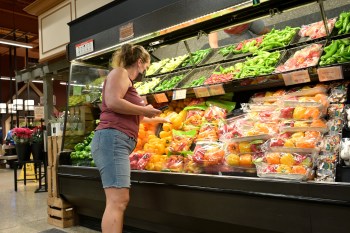Should the public know how much money Wal-Mart, or that convenience store down the street, takes in through the federal food stamp program? Or does that amount to a retail trade secret? Those are the questions at the heart of a request for public comment announced Monday by the U.S. Department of Agriculture, which runs the food stamp program.
Here’s the background: Last year we spent $76 billion tax payer dollars on the food stamp program (officially known as the Supplemental Nutrition Assistance Program or SNAP). That money goes to about 47 million low-income Americans, who use it to buy food at more than 250,000 retail stores across the country.
But, as I have reported here before, exactly which stores and which companies benefit most from those food stamp dollars is something the federal government has never disclosed. Officials have long argued they are required by law to keep the information secret, in order to protect retailers.
A few years ago the Argus Leader, a newspaper in South Dakota, sued the USDA, arguing the public has a right to see this data. The issue is still tied up in court. Last spring, when I interviewed Agriculture Under Secretary Kevin Concannon about the issue in March, he told me that in his opinion, greater transparency would be a good thing.
“I think personally it’s in the interest of the American public,” he said. “These are public benefits that are moving through the economy.”
Yet when I asked him if he would push his agency to disclose the information he said he needed to “talk to the lawyers.”
Judging from the USDA’s announcement Monday, the lawyers have been consulted.
In the press release announcing the agency’s request for public input, Concannon said: “Our goal is to provide more transparency so that people can have access to basic information about the amount of SNAP benefits that individual grocery stores and retailers are redeeming. We hope that this public comment period will be informative as to how we can do that in the most thoughtful and appropriate way possible.”
The USDA will take public comment until Sept. 8. As for what kind of comments might come in over the next month, we have some clues already.
When I asked Wal-Mart spokesman David Tovar last spring about how much revenue his company took in from food stamps, he told me it was proprietary information.
“We don’t provide our market-share data on any categories like that,” he said, pointing out that knowing how much a particular Wal-Mart in a particular location makes in food stamps could be helpful to competitors. “I think any information that a retailer shares about how they’re serving customers and how they’re going to market would be interesting to lots of other retailers.”
It’s worth pointing out that aside from being the nation’s largest retailer, Wal-Mart likely takes in the most food stamp dollars, an estimated 18 percent last year, according to leaked comments from a company vice president at a private dinner last fall, which Walmart later confirmed. That sum would amount to $13 billion, or about 4 percent of Wal-Mart’s total U.S. sales.
Wal-Mart is also one of several retailers that have a significant number of employees who make little enough that they rely on food stamps to get by. In Ohio, up to 15 percent of Wal-Mart’s workforce uses SNAP, based on our analysis of state food stamp enrollment data.
Outside the retail community, there are voices advocating for making the data public, arguing that it could help citizens and policy makers better understand which stores profit the most from food stamps, what kinds of foods they promote and sell, and what their business practices are.
“It could be used to improve SNAP and make it more accessible to poor families,” writes Stacy Cloyd, the Senior Domestic Policy Analyst at Bread for the World Institute, an anti-hunger organization. Knowing which stores attract the most SNAP customers would “allow hunger advocates to learn from successful businesses and share best practices. It would also help them identify the highest-volume vendors so that they can offer the stores information and recommendations on how they can supply a variety of nutritious foods,” she writes.
As Jonathan Ellis, the South Dakota journalist who sued the USDA to make food stamp data public, points out: “Typically, if a business participates in a government program, you can get a copy of their contract and find out how much they’re being paid.”
That’s how it works when the government pays a construction company to build a bridge, or a defense contractor to build a fighter plane.
But that’s not how it works when the government reimburses retail companies that participate in the federal food stamp program, at least for now.
There’s a lot happening in the world. Through it all, Marketplace is here for you.
You rely on Marketplace to break down the world’s events and tell you how it affects you in a fact-based, approachable way. We rely on your financial support to keep making that possible.
Your donation today powers the independent journalism that you rely on. For just $5/month, you can help sustain Marketplace so we can keep reporting on the things that matter to you.


















